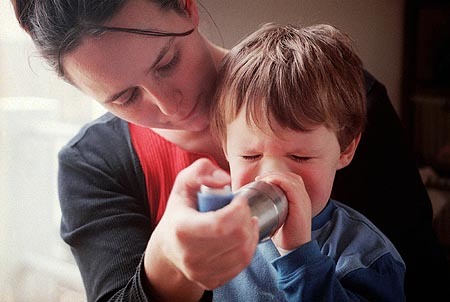If you have sleep apnea and asthma, you are not alone! Sleep apnea and asthma are both very common conditions in children and adults. Having one of them makes it more likely that you have or may develop the other one. Having both sleep apnea and asthma may also change how you respond to treatments for both. Why is that? There are probably many reasons.

Asthma and sleep apnea share many of the same risk factors. A risk factor is something that increases the chance you will develop a condition if you don’t already have it, or may make it harder to manage the condition if it is already there. Being overweight or obese, having nasal allergies, having gastroesophageal reflux disease (GERD), and having metabolic complications of obesity such as diabetes or metabolic syndrome are all associated with both asthma and obstructive sleep apnea. People with asthma, especially severe asthma, are more likely to develop sleep apnea. If they have sleep apnea that isn’t treated, it may be harder to get the asthma under good control. People with obstructive sleep apnea also have a higher chance of developing asthma over time.
There are a lot of theories about why sleep apnea and asthma interact with each other. Both conditions affect how air moves through the airway. In obstructive sleep apnea, the upper portion of the airway repeatedly collapses during sleep, blocking the flow of air. Airflow is reduced in asthma too, but usually lower down in the airways. Asthma doesn’t just occur during sleep, but for many people, the symptoms get worse at night. In both obstructive sleep apnea and asthma, when airflow is blocked, we can see swelling, inflammation, and a response to rapid changes in oxygen levels called oxidative stress. Many of these responses are very similar in obstructive sleep apnea and asthma. Some researchers have shown that if you block airflow one part of the airway, it makes other parts of the airways more prone to collapse or inflammation. This could be even more of a problem if you have some of the risk factors described above that increase the chances of developing both conditions.
Both asthma and sleep apnea can also lead to disrupted sleep if they aren’t well controlled, resulting in not feeling refreshed and rested, and having trouble concentrating or focusing during the day. Getting enough sleep and good quality sleep is so important to how we think and solve problems during the day. We ask people to do a lot of things at home to manage sleep apnea and asthma. If sleep is disrupted due to sleep apnea, asthma, or both, it can make it hard to follow your doctor’s advice and do all the things you need to do to manage your sleep apnea or asthma.
So what can you do? Talk to your health care provider! Asthma and sleep apnea are both conditions that may not be obvious to health care providers when you are in the office during the day, so they often go unrecognized or undertreated. We need to hear from you if you are having symptoms, or having trouble with the medicines or treatments that have been recommended so we can help or find different options that work better for you.
Some research studies suggest that treating sleep apnea may improve asthma outcomes in some cases, but we still have a lot to learn about this area. We need your help and participation in research studies to do that. Ask your healthcare provider about opportunities to participate in research studies, or to talk to other patients and families who have participated in research to hear about their experiences. You can also find research studies on the website clinicaltrials.gov by searching for keywords such as asthma and sleep apnea. One example is the Pediatric Adenotonsillectomy Study for Snoring (found on clinicaltrials.gov under the registration number NCT02562040), currently enrolling children ages 3 to 12 years old with snoring and mild sleep disordered breathing. In this study, children are randomly assigned (like with a flip of a coin) to either early surgery to remove tonsils and adenoids, or watchful waiting for a year with close follow up by the research team. The purpose of the study is to evaluate the effects of early adenotonsillectomy on the behavior, sleep disordered breathing symptoms, and quality of life. Children enrolled will be screened for asthma or asthma type symptoms, and the effect of early adenotonsillectomy on asthma outcomes will also be studied. In adults with asthma and OSA, studies are being done to learn the effect of using CPAP on asthma outcomes.
Kristie R Ross, M.D.,
Associate Professor of Pediatrics at
Case Western Reserve University School of Medicine and
UH Rainbow Babies and Children's Hospital
Citations:
Both my children had obstructive sleep apnea, asthma, and allergies.
But once the sleep apnea was resolved the asthma attacks and allergies improved. The youngest child had an adenotonsillectomy over 3 years ago and has not used his blue inhaler or been hospitalized since. Whilst the older child had is adenotonsillectomy last year and seems to have improved, not been hospitalized, but still needs his blue inhaler now and then.